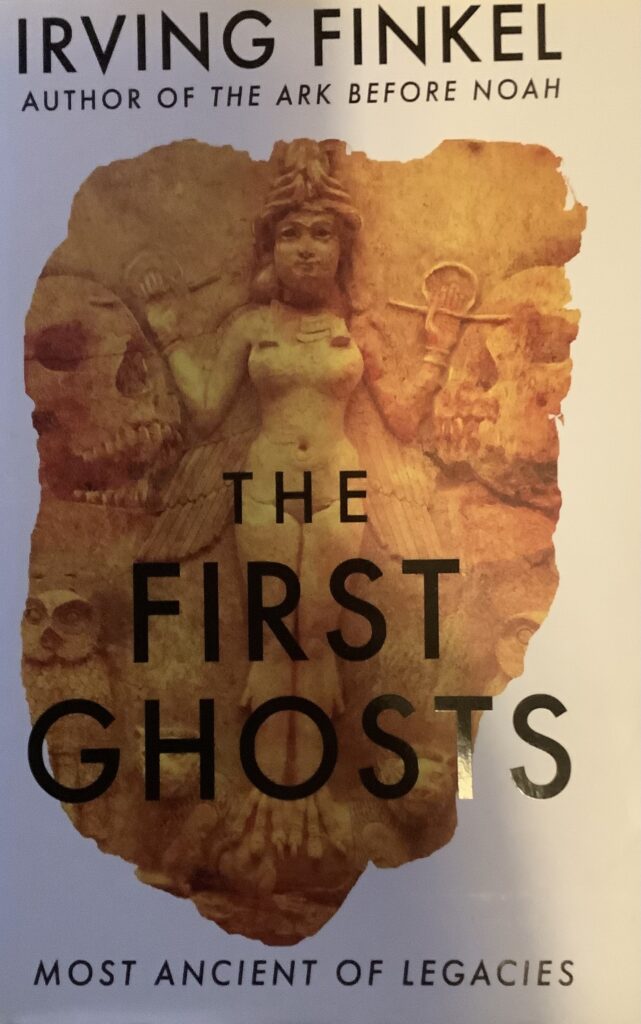
. London: Hodder & Stoughton, 2021. 344 pp. ISBN: 9781529303261 £25.00
Irving Finkel, Senior Assistant Keeper of Ancient Mesopotamian script, languages and cultures in the Middle East Department of the British Museum, has here assembled a detailed study of ghosts (and some spirits) from the approximately 130,000 cuneiform tablets that the museum currently holds. In fact, as I read it I realised that I was actually watching ghosts rise before my own eyes: the ghosts of apparently long-dead Sumerian, Babylonian and Assyrian beliefs about denizens of other worlds, brought forth by Finkel’s deft analysis and given new life thanks to his effortless prose.
Until I read this book I hadn’t realised how prevalent belief in ghosts had been in the Mesopotamian cultures of millennia past for, as the author shows throughout, these ancient peoples took the existence of denizens of the Netherworld for granted much as we take the existence of dogs and cats for granted in our own world. Not for nothing have those distant cultures been described as ‘demon haunted.’ The damned things were everywhere; ghosts especially, and many of the omens, spells and incantations examined throughout this study were designed, above all, to seek to control them: to send them back down when for whatever reason they came back up, to bring them up if for whatever reason they were needed up here rather than down there, and to make sure they did what was needed – and no more – in their brief sojourns in the land of the living before they were safely tucked up again back down below in the land of the dead. And, as Finkel shows in detail, such ups and downs were no mere metaphors. The dead really did, within these cultures, live down there. Hence, keeping ghosts – particularly family ones – ‘onside’ (or, more correctly, ‘downside’) meant more often than not burying them under the floor of your house and ministering to them via correct ritual and libation in the ways that many of these Sumerian and Akkadian tablets prescribed.
Whilst the bulk of this book is to do, as the title suggests, with ghosts, there is much more to it than this. In its middle chapters Finkel treats us to a range of what he dubs ‘Netherworld Stories’ involving the descents of Inanna, Ishtar, Gilgamesh, Enkidu and others. And in the latter stages we are introduced to ‘The Delicate Art of Necromancy’: how to bring up the dead in such ways that they could be guaranteed to help rather than hinder (or worse) the living. For example: bringing ghosts up might be one thing but hearing them howl or wail meant that you would soon join them. Hence the complexity of necromancy revealed in the tablets the author translates and presents. A successful calling-forth meant, amongst other things: bringing up the (right) ghost, keeping it from wailing (or keeping yourself from hearing it wail), and banishing it back successfully whence it came. Of course, more often than not, the only thing that anybody would want to do with a ghost would be to keep it away from the living as far as possible on any and every conceivable occasion. Hence amulets for, as the author puts it, ‘wearing against unknown visitants.’ Typical is the following: ‘If a person often sees dead people in his dreams you stitch up ‘dog’s-tongue’ and a soiled rag in the hide of a dead cow with a dormouse tendon and put it around his neck.’ This attention to detail seems to have been a consistent feature of such ‘ghost-science’: a right outcome was, above all, only seemingly guaranteed if you got it right.
In devoting much time to ghosts, Finkel is careful not to overlook demons too. In fact, by the latter stages of this (perhaps paradoxically) engaging study I felt that I’d come to know these evil personages as something approaching friends. I certainly knew their names: Lamashtu (the Baby-Snatcher), Ahhazu (the Grabber), Shulak (the Lurker-in-the-Toilet), and Rabisu (the Croucher) to name but a few.
In less capable hands this study would have been as dry as the dust that was needed to successfully cast many of the spells that the author painstakingly reassembles throughout. But Finkel shows deft stylistic touches everywhere – particularly in his treatment of the ‘Ghost-Mistress of Endor’ within a chapter devoted to the separate but related ‘Biblical World’ – and even suggests that the reader recite some of his translated incantations aloud. I preferred not to do this, mindful of what might happen if I accidentally summoned something I couldn’t successfully put back. This, in itself, shows how captivated I was with the whole thing. And this, for me, was the real triumph of The First Ghosts: that the author took the dry clay of long-hidden cultures and made it live.
This review first appeared in De Numine, Issue 75, Autumn 2023, pp. 23 – 4